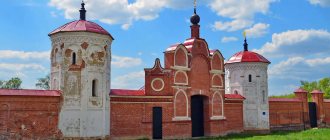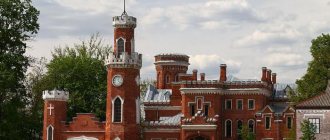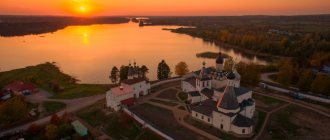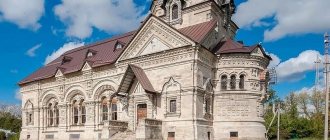Oryol region is considered one of the smallest. It was formed in 1937 and is part of the Central Federal District. Consists of twenty-four municipal districts. The total population for 2022 is 733,682. The regional center is the city of Orel, located in the south, 410 kilometers from Moscow.
Trinity Nativity of the Virgin Mary Optin Monastery, Bolkhov
Oryol region on the map of Russia
You can find the Oryol region on the map and get directions using your navigator using the coordinates (52.781455, 36.481042). In the north it borders with the Kaluga region, in the north-west - with the Bryansk region, in the west and north-west - with the Kursk region, in the east - with the Tula region. In the south and southeast with the Lipetsk region.
Oryol district
It is one of the administrative-territorial units of the Oryol region. The center is Orel, which, at the same time, is not part of the district.
The Oryol district is located in the central part of the region of the same name, surrounding the city of Oryol on all sides. Its area is 1701.4 km2. It was formed on July 30, 1928. For some time it was part of the Kursk region.
The area's population grew rapidly until 1970, and then growth was very slow. In recent years, the population has been declining slightly. The share of the urban population is 16.5%. In total, the district includes 17 municipalities (1 urban and 16 rural).
Agriculture is in great decline. In the future, it is planned to build a waste recycling plant. Basically, the population living in the region studies and works in the capital of the region.
The villages of the Oryol district of the Oryol region are 4 settlements:
- village of Zilina;
- Polozovsky Dvors;
- Stanovoe village;
- Nizhnyaya Kalinovka.
The remaining settlements in this category are divided into villages and towns: 8 villages and 4 towns.
Climate
The climate of the Oryol region is temperate continental, with warm summers and moderately frosty winters, with a well-defined change of seasons. From the northwest to the southeast of the region, signs of continentality increase. The weather in the Oryol region depends on the movement of Atlantic air masses, which have changed significantly when passing over Europe. The entry of Arctic air into the region in winter brings frosts and cool weather in summer. In summer, warm tropical air masses come from the south. The coldest month is January, the average temperature is −11. In July, the average temperature is +21. The number of sunny hours is 1600-1800 per year.
Eagle
Epiphany Cathedral
© Anna Kudryavtseva
Oryol is famous for its many attractions. One of them is the Epiphany Cathedral. The temple, built in the 40s of the 17th century, is considered the oldest stone building in the city. Initially, the Orthodox church shrine belonged to the Epiphany Monastery, which was abolished in 1680. To this day, in the Epiphany Cathedral, located in the central part of Orel, on the river bank, ancient icons, which are credited with miraculous properties, have been preserved. The temple is located on the square of the same name - Epiphany.
When going on a tour of Orel, you cannot ignore the Assumption Monastery, which is of great interest to tourists. Previously, on the vast monastery territory there was a bishop's house with many buildings of various types and purposes. Unfortunately, only the two-domed Trinity Church-tomb has survived to this day. It was built over the course of 2 years, from 1843 to 1845. The initiator of the construction was the local governor Kochubey. The shrine was conceived as a memorial temple, next to which the manager’s relatives - mother, wife and two sons - were laid to rest. Unfortunately, today nothing remains of the graves, but the church still exists. At the beginning of the 21st century, a beautiful chapel was built next to it and named it in honor of Alexander Nevsky. Directly below it there is a well with the purest artesian water. Its depth is 148 m. The well water is blessed, and anyone can taste it.
The city is home to another remarkable Orthodox monastery - the Vvedensky Convent for women. The ancient building was abandoned in 1923 and gradually collapsed over the course of 70 long years. In the early 90s of the 20th century, the city authorities decided to restore the shrine. Restoration work continues to this day. One of the main assets of the monastery is the list of the Balykino Icon of the Mother of God. This list, endowed with miraculous properties, was donated to the monastery by St. John of Tobolsk back in 1712.
If we talk about the worldly attractions of the city, then there are no less of them. The shopping arcades dating back to the 18th century are extremely interesting. The building, which stretches for an entire block, has a sad history. Some time after its construction, it was severely damaged by fire. The shopping arcades burned out almost completely, but, fortunately, they were restored in the mid-19th century.
Tourist Multifunctional Complex "GRINN"
© Anna Kudryavtseva
In the 60s of the 20th century, a memorial memorial appeared on the territory of Orel, dedicated to the anniversary date - the 400th anniversary of the founding of the city. Compositionally, this monument is a huge obelisk made of granite, stretching up 27 meters. Various dates directly related to the history of the Eagle are engraved on its surface. It is known that under the obelisk its founders walled up a letter addressed to future generations of the 21st century. By the way, the memorial is located directly at the confluence of Orlik and Oka.
The tourist complex "Grinn" is of genuine interest to city guests, on the territory of which and next to it there is a large number of sculptural and architectural monuments, both ancient and modern. One of the attractions is the Boyarskoe cafe, stylized as antique. Not far from it there is a museum complex, the exhibition of which tells about the history of the construction and development of Orel from its origins to the present day.
Another place that guests of Orel should definitely visit is the “Noble Nest”. A magnificent green square is geographically located on the left bank of Orlik. According to legend, in this landscape area there was once an ancient estate, which the famous writer I. S. Turgenev described in his work of the same name. On the very outskirts of the park, a beautiful wooden gazebo, nicknamed “Turgenevskaya”, was erected. A marble bust of the writer was placed next to it and a convenient observation deck was equipped.
The city of Orel has a large number of museums - as many as ten, with 6 of them dedicated to Russian literature and famous writers and poets of different eras, whose life was in one way or another connected with the Oryol province. Thus, Oryol is a real paradise for connoisseurs of Russian classics.
You can relax and relax by visiting local theaters or strolling through charming parks and squares. One of these parks called “Oryol Polesie” is literally breathtaking! On a beautiful territory of several hectares, a huge number of fauna representatives live almost in natural conditions. Luxurious enclosures have been built for animals and birds, the size of which allows the inhabitants to feel free.
Orel has several interesting architectural monuments. Masterpieces of estate architecture include the museum-estate of Spasskoye-Lutovinovo, Saburovo-Kamenskoye, the house of governors, and the wooden house of the Fomichevs. The local Rodina cinema has a unique history and enormous cultural significance.
In a word, visiting Orel does not make any tourist bored. Almost every corner of this city evokes curiosity and a desire to explore it better.
Sights of the Oryol region
- State Memorial and Natural Museum-Reserve I.S. Turgenev is located in the Spasskoye-Lutovinovo estate. The center of the museum's exhibition is the house of Ivan Sergeevich. There are many personal belongings of the writer and things he inherited in the house. Together with the house, the museum complex includes: the Church of the Transfiguration, the Outbuilding, and a magnificent ancient park.
- Saburovo Fortress is an abandoned noble estate of the Kamenskys in the village of Saburovo. It is considered an architectural monument and one of the main attractions of the Oryol region. Behind the garden wall, built in the style of a fortress wall with four towers, is the theater building and the Church of St. Michael the Archangel, built in 1755.
- The spring is a tributary of the Oka in the village of Aleksandrovka, Glazunovsky district, Oryol region. The Oka River, the largest right tributary of the Volga, originates here.
- Oryol Polesie National Park is a nature reserve. The park, covering an area of more than 770 square kilometers, is home to about three hundred species of animals. These include bison and specially imported African ostriches, which have adapted well to the local climate. In the park you can watch wild animals, watch bison feeding and taste an ostrich egg omelet.
Historical and geographical information
The Oryol region is located in the southwestern part of the European territory of Russia, in the center of the Central Russian Upland, in the southern part of the Central Economic Region.
In the northern direction, the region borders with the Kaluga and Tula regions, in the western - with Bryansk, in the southern - with Kursk and in the eastern - with Lipetsk regions. The length of the territory from north to south is more than 150 km, from west to east - over 200 km. Territory area - 24.7 thousand square meters. km, population - 834 thousand people at the beginning of 2006. Of these, just over 60% live in urban settlements, the rest are residents of rural areas. The surface is a hilly plain, a zone of transitional soils from sod-podzolic to predominantly leached and podzolized chernozems. Oryol region is middle Rus', the center and heart of Russia. The richest Russian region, called by our fellow countryman I.A. Bunin “the fertile steppe,” played and still plays a significant role not only in the material, but also in the state, in the spiritual development of our people. Even in the chronicles of the 12th century, the cities of Mtsensk, Novosil, and Kromy are mentioned as being the same age as Moscow. Four centuries later, the fortress cities of Bolkhov, Orel, and Livny were founded. The Oryol region more than once became the site of battles with Tatar nomads; the dramatic events of the Time of Troubles at the beginning of the 17th century unfolded here. Oryol residents were service people on the turbulent borderland, which resisted Tatar raids and protected Moscow from a fierce enemy. With the expansion and strengthening of the Russian state, the lands surrounding Orel were transformed by tireless peasant labor into a fertile granary, which gave Orel the glory of a grain city. For centuries, river plows and sleigh carts with bread, hemp, lard, and all other supplies went from here. Later, Orel, located on the Oka River, became the center of an extensive grain market, supplying Moscow with grain and flour. During the reign of Peter the Great, Orel received the status of the center of the Oryol province, and at the end of the 18th century - the center of the Oryol province, which included a significant part of the current Bryansk and Lipetsk regions. The wonderful Central Russian nature, wise peasant traditions and primordial folk culture became the fertile soil on which a whole galaxy of talents known not only in Russia, but throughout the world grew up. Oryol region is the birthplace of writers I.S. Turgenev, N.S. Leskov, L.N. Andreev, poets A.N. Apukhtin, A.A. Fet, philosophers S.N. Bulgakov, M.M. Bakhtin, historian T N.Granovsky. The life and work of F.I. Tyutchev, I.A. Bunin, and M.M. Prishvin are connected with the Oryol region.
Starting from the second half of the 19th century, railways and highways connected Orel with Moscow and Ukraine, the Baltic states and the Volga region, making the city a major transport center. On the eve of the 1917 revolution, a cadet corps, a theological seminary, and several gymnasiums were located in Orel (the future Prime Minister of Russia P.A. Stolypin graduated from one of them). In the fall of 1919, bloody battles between the troops of General Denikin’s Volunteer Army and the Red Army took place near Orel and Kromy. After the revolution, the Oryol province underwent significant administrative and territorial changes: in 1920, in connection with the formation of the Bryansk province, Bryansk, Karachevsky, Sevsky and Trubchevsky districts were separated from the Oryol province, then in 1928 the territory of the Oryol province became part of the Oryol and Yeletsky districts the newly formed Central Black Earth Region. In 1934, Oryol and surrounding areas became part of the Kursk region.
The Oryol region was formed by the Decree of the Central Executive Committee of the USSR on September 27, 1937. In 1944, the Bryansk region was separated from the Oryol region, and in 1954, in connection with the formation of the Lipetsk region, 9 more eastern districts were separated from the Oryol region. The Oryol region became the site of fierce fighting during the Great Patriotic War - the front line passed through the region for twenty-two months.
In honor of the liberation of Orel, on August 5, 1943, the first fireworks display during the Great Patriotic War was given in Moscow.
Oryol region is the birthplace of 179 Heroes of the Soviet Union, 30 full holders of the Order of Glory. In 2007, by Decree of the President of the Russian Federation V.V. Putin, the city of Orel was awarded the honorary title “City of Military Glory”.
War: Oryol region 1941–1945
Zoya Emelyanova, June 21, 2022, 00:11 — REGNUM For almost two years, the territory of the Oryol region was under Nazi occupation. During this time, many settlements were literally wiped off the face of the earth: the occupiers burned entire villages, destroyed schools and hospitals. More than 80 thousand civilians - old people, women, children - were brutally killed, about 200 thousand were driven into German slavery.
The population of Orel welcomes the Soviet units that liberated the city. August 5, 1943
Before the Great Patriotic War
The Oryol region was created as part of the RSFSR in 1937. At that time, the region included 25 districts from the Kursk region, 29 districts from the Western region (the territory of the current Smolensk, Bryansk, Kaluga and Tver regions) and five districts from the Voronezh region.
Thus, by the beginning of the Great Patriotic War, the Oryol region included: the city of Orel, Bolkhovsky, Verkhovsky, Volynsky, Dolzhansky, Droskovsky, Zalegoshchensky, Znamensky, Izmalkovsky, Kolpnyansky, Korsakovsky, Krasnozorensky, Kromsky, Livensky, Mokhovsky, Mtsensky, Nikolsky, Novoderevenkovsky , Novosilsky, Oryol, Pokrovsky, Russko-Brodsky, Sverdlovsky, Soskovsky, Telchensky and Uritsky districts (from the Kursk region); Brasovsky, Bryansky, Gordeevsky, Dubrovsky, Dyatkovsky, Zhizdrinsky, Zhukovsky, Karachevsky, Kletnyansky, Klimovsky, Klintsovsky, Komarichny, Krasnogorsky, Lyudinovsky, Mglinsky, Navlinsky, Novozybkovsky, Pogarsky, Pochepsky, Rognedinsky, Sevsky, Starodubsky, Suzemsky, Surazhsky, Trubchevsky, Ulyanovsk, Unechsky, Khvastovichsky and Shablykinsky districts (from the Western region); Yeletsky, Zadonsky, Krasninsky, Stanovlyansky and Chibisovsky districts (from the Voronezh region). In total, the region included 66 administrative districts, 23 cities, 22 workers' villages and 1,264 village councils.
The total number of residents of the Oryol region at the beginning of the Great Patriotic War was 3.5 million people.
German shielded tanks Pz.Kpfw. III in a Soviet village before the start of Operation Citadel. June - July 1943
German self-propelled gun "Wespe" of the 2nd Wehrmacht tank division in the Orel area. July 1943
Germans in the Oryol region
The Wehrmacht offensive on Orel began on September 30, 1941, and already on October 3 the Germans approached the city. On the southwestern outskirts of Orel, in the area, Guderian's 2nd Tank Army was met by soldiers of the 146th separate convoy battalion, stationed in Orel, and paratroopers of the 201st Airborne Brigade (VDBr) of the 5th Airborne Corps (VDK) . By the time the troops landed, the airfield had already been captured by the enemy. The enemy forces significantly outnumbered the defenders, and a few hours later the Germans broke into Oryol.
By the end of November 1941, the enemy occupied the Oryol region within its modern borders, and while the eastern regions were soon recaptured, the main part of the region remained in German hands for a long 22 months.
SS soldiers in a field near a village near Orel. 1943
In the occupied territory of the region, commandant's offices were created, as well as local administrations from local residents who agreed to cooperate with the enemy. Among the priority measures in the occupied territories, the Nazis began clearing the territories of communists and Komsomol members - they also assigned this responsibility to commissions, which included, among other things, local residents “from among those dispossessed or offended by the Soviet government.”
Soviet partisans are leading the arrested former police officer Dolgov, who served in the German occupation administration, in the village of Kurganovka, Oryol region. 1943
According to eyewitnesses, the Nazis saw a threat not only in communists and Komsomol members, but also in books.
“Russian books were confiscated from the reading rooms. There was no “Poltava” by Pushkin in the history of the Russian people. To us M. Oktan (real name Ilyin, editor-in-chief of the newspaper “Rech”) in his newspaper (the newspaper “Rech” was published by the occupation authorities in Russian) explained that the poem was seized “for excessive praise of the military valor of the Russians.” And “War and Peace” was also confiscated “for deceitful patriotism and partisanship,” recalled Gusev, a doctor at the underground hospital.
During the 22 months of occupation of the Oryol region, 825 hospitals, 2,483 schools, theaters, museums, and cinemas were destroyed. About 200 thousand residents of the region were deported to Germany for work. About 80 thousand civilians were killed by the enemy. The cities of Novosil, Livny and the village of Verkhovye were completely destroyed. The national archive “Living Village” - a register of Soviet villages burned during the war - currently includes 53 Oryol villages. In Orel itself, the Germans destroyed more than 2.2 thousand residential buildings, 33 educational institutions, a telephone exchange, cultural institutions, a radio center, shops, and kindergartens.
Soviet refugee children from the village of Yagodnaya, Oryol region. July 22, 1943
“Droskovsky district, Muratovo village. More than 60 old people, women, children were robbed, locked in a cold barn (January 1942), where they were kept all night, and in the morning they were taken outside the village of Leski into a ravine and everyone was shot with a machine gun,” such facts were not isolated in the Oryol region
On the territory of the Oryol region during the occupation, at least 25 concentration camps were created - both for prisoners of war and for civilians, and even for Germans who refused to fight. Such a camp was created in the area of Art. Optukha.
Peasant woman Natalya Nikolaevna Polyakova points out to the commander of the guard reconnaissance group, Lieutenant G. A. Borodin, the direction along which the enemy unit passed. North of the city of Orel. 1943
Soviet partisans study captured German documents. Oryol region, 1942
Partisans were active in the Oryol region - during the war, 166 partisan formations were created, more than 60 thousand people fought in them. Among the most famous actions of the Oryol partisans was the blowing up of more than 64 km of rails on the night of July 22, 1943, which actually disrupted communications from Oryol to Bryansk, Lgov and Gomel for a month. Underground groups also blew up ammunition depots, carried out sabotage on railways, and killed traitors.
In Orel, literally before the eyes of the invaders, an underground hospital operated, whose doctors helped wounded soldiers of the Red Army: the hospital was set up in the officially operating “Russian hospital”. On August 5, the day of the liberation of Orel, 200 rescued soldiers and officers were transferred from the Red Army hospital.
Commander of the 112th Tank Brigade, Colonel M. T. Leonov on the Kursk Bulge. July 1943
Army General K.K. Rokossovsky and officers inspect the trenches of Soviet soldiers. Kursk Bulge. 1943
Battles in the Oryol region
The fighting on the territory of the Oryol region lasted a total of 24 months - from October 1941 to October 1943. But the largest battle in the region was the Oryol strategic offensive operation “Kutuzov”, carried out from July 12 to August 18, 1943, which also went down in history as part of the Battle of Kursk.
Women remove rubble from the streets of liberated Maloarkhangelsk. February - March 1943
Panther tanks in the Orel area. 1943
In February 1943, the Red Army liberated the Kursk region. However, the Nazis did not abandon their offensive plans: in the summer of 1943 they intended to carry out Operation Citadel. According to the plans of the Nazis, after two strikes in the direction of Kursk and the destruction of units of the Red Army in the Kursk ledge area, the Wehrmacht was supposed to launch an offensive against Moscow from the Oryol bridgehead.
Mechanic-driver of the T-34 of the 5th Guards Tank Army before the battle on the Kursk Bulge. June 1943
Crew of the 82-mm mortar BM-41 of the 6th Guards Motorized Rifle Brigade on the Kursk Bulge. July 1943
The Battle of Kursk, which became a turning point in the Great Patriotic War and one of the key battles of the Second World War, took place in the Oryol, Kursk, Belgorod and Kharkov regions on July 5. Operation Kutuzov to liberate the Oryol region became part of the Red Army's counteroffensive.
Soviet soldiers near the wreckage of a downed German plane. Kursk Bulge, July 1943
Soviet artillerymen at a 120-mm regimental mortar of the 1938 model at a position on the Kursk Bulge. July 5, 1943
Red Army soldiers inspect Wehrmacht equipment destroyed during the battles near Orel. July 1943
The troops of the Western and Bryansk Fronts began the offensive in the Oryol direction on July 12; on July 15, the Central Front launched a counteroffensive and recaptured the lines previously occupied by the Germans on July 18. On the morning of July 19, the troops of the Central Front launched a strategic offensive in the Kursk-Krom direction.
Preparing for the flight of the Pe-2 reconnaissance aircraft at the Red Hill airfield. Oryol-Kursk arc. 1943
Loading the wounded onto a U-2 plane for evacuation. Oryol direction. 1943
Already in the first two days of the offensive, troops of the Western and Bryansk fronts broke through the enemy’s tactical defense zone on the Oryol-Kursk Bulge. The wide offensive zone allowed the forces of the Central Front to strike in the direction of Krom. On July 29, the Red Army liberated Bolkhov, and already on August 5, Soviet troops cleared Oryol of the enemy. In Moscow on August 5, fireworks went off in honor of the liberation of Orel and Belgorod. The entire Oryol region within its modern borders was liberated on August 18.
A Soviet officer assigns a combat mission to his subordinates. 1943
Soviet mortarmen with an 82-mm mortar of the 1937 model in position during the fighting on the Kursk Bulge. July - August 1943
In the 38 days that Operation Kutuzov lasted, the Red Army advanced 150 km. Enemy losses amounted to 15 divisions, about 88.9 thousand people. This victory was not easy for the Soviet troops either: more than 112.5 thousand people were listed as killed or missing, more than 317 thousand military personnel were wounded. The Red Army lost 2.5 thousand tanks and self-propelled guns, almost 900 guns, and more than a thousand combat aircraft.
The Oryol liberation operation became the beginning of a general offensive of the Red Army towards the west.
The priest of the city of Dmitrovsk-Orlovsky blesses Soviet soldiers before the battle. August 1943
Soviet soldiers rest on Pervomaiskaya Square in liberated Orel. August 5, 1943
Eternal memory to the heroes
In the Oryol region, as in any Soviet region, many monuments to the defenders of the Motherland were erected during the war and post-war years. One of the first mass graves in Orel appeared on August 5-7, 1943 - in Pervomaisky Square, which on August 18, 1943 was renamed Tankmen Square and bears this name to this day, tankers - the defenders of the city - were buried. A T-70 tank was installed on the grave. In 1963, the Eternal Flame was lit at the mass grave.
Fellow soldiers and family of the deceased hero. Oryol region, 1943
Funeral of Red Army soldier V. A. Yatsenevich in the village of Glazunovka, Oryol region. July 1943
In total, during the war years, the title of Hero of the Soviet Union was awarded to 167 natives of the Oryol region, two more Oryol residents received the stars of Heroes of Russia for their exploits during the war years in 1995. Ivan Martynov was awarded two Orders of Lenin - the young man organized a major explosion on the railway.
Red Army machine gunner V.I. Obraztsov with a banner in liberated Orel. August 5, 1943
Soviet citizens hang out a red flag in the newly liberated city of Orel. August 1943
Return to peaceful life
The return to peaceful life for the Oryol residents was joyful, although extremely difficult. After months of occupation, many settlements were completely destroyed. According to the decree of the Council of People's Commissars of the USSR dated November 1, 1945, “On measures to restore the cities of the RSFSR destroyed by the German invaders,” Orel was among the 15 largest and oldest Russian cities that suffered the most during the war.
The damaged German self-propelled gun "Ferdinand" and Soviet collective farmers at work in the field. 1943
The hard work of restoring Orel began in the first days after the liberation of the city. The Germans were still being driven across Oryol land when Oryol residents, mostly women, old people, children and teenagers, began to raise the city from the ruins.
A column of German prisoners of war captured in battles in the Oryol direction. 1943
Civilians at the entrance to a dugout in the liberated village of Vasilyevka, Oryol region
In less than a month - by September 1, 1941 - eight canteens, 15 shops opened in Orel, two schools, two hospitals and five hospitals were opened. Peaceful life was slowly restored: they began to bake bread, train traffic was restored, the power plant and water supply started working. Among the first enterprises to be restored. By May 9, 1945, dozens of industrial enterprises, 1,750 schools were already operating in the Oryol region, 545 post offices, 677 medical institutions were opened, and 30 thousand residential buildings were restored. More than 36.2 thousand residents of the region were nominated for medals “For Valiant Labor in the Great Patriotic War of 1941–1945.”
Read the development of the story: War: Lipetsk region 1941-1945
The Oryol region is the center and heart of the country, a unique corner of the Russian land, which is picturesque at any time of the year. Along its roads stretch endless arable lands, turning either into broad-leaved forests or into the beginning steppes... No wonder Ivan Bunin called this land dear to his heart “a fertile substeppe.”
The Oryol region is located in the southwestern part of the European territory of Russia, in the center of the Central Russian Upland, in the southern part of the Central Economic Region. To the north (300 km south of Moscow) the region borders on the Kaluga and Tula regions, to the west - to the Bryansk region, to the south - to the Kursk region and to the east - to the Lipetsk region.
The region is located in the central part of the Central Russian Upland within the steppe and forest-steppe zones. The climate is temperate continental. The average temperature in January is -8 - 10°C, in July +18 - 19°C.
There are more than 2 thousand rivers and streams in the territory with a total length of 9100 km, but there are no navigable rivers. The main river of the region is the Oka, a tributary of the Volga.
The area of the region is 24.7 thousand square meters. km. Population - 770 thousand people, including: urban - 507.6 thousand people (66%) and rural - 262.4 thousand people (34%).
The total number of municipalities in the region is 267, including 3 urban districts (Orel, Livny and Mtsensk), 24 municipal districts, 17 urban settlements and 223 rural settlements. The administrative center of the region is the city of Orel, whose population is 317 thousand inhabitants. The largest cities are Livny with a population of 51 thousand people and Mtsensk - 45.4 thousand people.
Natural resources
The Oryol region has various types of mineral resources, many of which are currently not being developed and are in reserve. Iron ore reserves in the Oryol region are a continuation of the Kursk magnetic anomaly. Limestones, sands and clays have a variety of uses in the production of building materials. There are deposits of limestone and dolomite (calcium carbonate) in almost all areas of the region. Reserves of pure white chalk, as well as white clay (kaolin) are located in the Dolzhansky district. In addition, the region has reserves of brown coal and peat.
The area of the region's forest fund is 193.7 thousand hectares, or 7.4% of the entire territory. The predominant position is occupied by deciduous and mixed forests: more often - oak, birch, pine, aspen, spruce; less often - maple, linden, alder, larch, rowan.
The region's flora and fauna are diverse: 64 species of mammals, about 240 species of birds and more than 300 species of invertebrates and fish live here.
Historical reference
The oldest cities of the modern Oryol region - Mtsensk, Novosil, Kromy, are mentioned in chronicles dating back to the 12th century. Four centuries later, the fortress cities of Bolkhov, Orel, and Livny were founded. The Oryol region more than once became the site of battles with Tatar nomads. Its inhabitants were service people on the turbulent borderland, which resisted raids, covering Moscow from the enemy.
With the expansion and strengthening of the Russian state, the lands surrounding Orel were turned into a fertile granary, giving it the glory of a grain city. River plows and sleigh carts with food went from here for several centuries. During the reign of Peter I, the city received the status of the center of the Oryol province, and at the end of the 18th century - the center of the Oryol province, which included a significant part of today's Bryansk and Lipetsk regions. In the second half of the 19th century, railways and highways connected Orel with Moscow, Ukraine, the Baltic states and the Volga region, making it a major transport hub.
On the eve of the 1917 revolution, a cadet corps, a theological seminary, and several gymnasiums were located here (one of which the future Prime Minister of Russia P.A. Stolypin graduated from). In the fall of 1919, bloody battles between the troops of General Denikin’s Volunteer Army and the Red Army took place near Orel and Kromy.
In the 20s of the last century, the Oryol province underwent significant administrative and territorial changes: in 1920, in connection with the formation of the Bryansk province, Bryansk, Karachevsky, Sevsky and Trubchevsky districts were separated from Oryol, then in 1928 the territory of the Oryol province as Oryol and Yeletsk district became part of the newly formed Central Black Earth Region. In 1934, Oryol and surrounding areas became part of the Kursk region. The Oryol region was formed in September 1937. In 1944, the Bryansk region was separated from its composition, and in 1954, in connection with the formation of the Lipetsk region, nine more eastern regions were separated.
During the Great Patriotic War, the region became the site of fierce fighting: the front line passed through its territory for 22 months. In honor of the liberation of Orel, on August 5, 1943, the first fireworks display during the war years was given in Moscow. In 2007, Orel was awarded the honorary title “City of Military Glory.”
Natives of the Oryol land are known not only in Russia, but throughout the world, among them: writers I.S. Turgenev, N.S. Leskov, L.N. Andreev, poets A.N. Apukhtina, A.A. Fet, philosophers S.N. Bulgakova, M.M. Bakhtin, historian T.N. Granovsky. The life and work of F.I. are connected with the Oryol region. Tyutcheva, I.A. Bunina, M.M. Prishvina.
Economy
In the Oryol region, 870 enterprises operate in the industrial sector, including 236 large and medium-sized and 290 small. In the structure of industrial production, the manufacturing sector accounts for 81.2%, the production and distribution of electricity, gas and water - 18.5%, mining - 0.2%. Each industry has its own leading enterprises, many of them occupy leading positions in the country's domestic market. The basis of the potential of the real sector is “Kerama Marazzi” (building ceramics); HMS "Livgidromash", "Livnynasos" (pumping equipment); Mtsensk Municipal Engineering Plant (municipal equipment); "Frigoglass Eurasia" (commercial refrigeration equipment); "Dormash" (road construction equipment), etc.
A scientific and industrial cluster for special instrument making, communications systems, automated control systems and cybersecurity is being formed in the region.
The agro-industrial complex occupies a special place in the region's economy. The region is implementing a program for the development of agriculture and regulation of markets for agricultural products, raw materials and food. The priority direction of the agro-industrial complex is livestock farming. The largest agricultural enterprises of the Oryol region are: Znamensky Agricultural Center, Agrofirma Miratorg, Orel-Agro-Product, Kurakinskoye, Agrofirma Mtsenskaya. In addition, reconstruction and modernization of existing dairy complexes and farms is being carried out.
Transport
The Oryol region has a fairly developed transport infrastructure, combining road, rail, urban electric transport and related infrastructure facilities (roads, railway stations, tram and trolleybus lines). The length of public railway tracks is more than 650 km. The major railway junctions in the region are the stations Orel, Livny, Mtsensk, Verkhovye, Luzhki. The length of paved roads is about 5,600 km.
Urban electric transport plays an important role in the transportation of passengers in the regional center, the city of Orel. The operating length of tram tracks is 18 km, trolleybus lines - 46.8 km.
Education
The Oryol region is a region of students. The higher education system here is represented by 7 federal educational institutions and 7 branches, in which 39 thousand people study in 226 specialties. The main direction of their activity is training personnel in the fields of education, culture, agriculture, construction, industry and healthcare. The main universities in the region: State University - Educational-Research-Production Complex, Oryol State University, Oryol State Agrarian University, Oryol State Institute of Arts and Culture. All universities have active employment assistance centers. In the region, special attention is paid to supporting talented youth. Interuniversity Olympiads in 45 subjects and an interuniversity competition of scientific student projects are held. More than 130 students become their winners and prize-winners. 500 personalized scholarships from the governor of the Oryol region have been established for the most talented students and graduate students.
The regional vocational education system includes 20 professional educational organizations and 14 branches. There are two multifunctional centers of applied qualifications: the Oryol College of Agribusiness and Service and the Oryol Technological College.
Culture
Despite the fact that in terms of total area the Oryol region is perhaps the smallest subject of the Russian Federation, on its territory there are thousands of cultural, historical and archeological monuments - a total of 1,706 monuments, including: archeology - 320, history - 910, architecture and urban planning - 464 monumental art - 12.
The literary phenomenon of the region is textbook known - it was here in the 19th century that the so-called “literary nest” was born, from which I.S. Turgenev, N.S. Leskov, A.A. Fet, I.A. Bunin, L.N. Andreev, D.I. Pisarev, A.N. Apukhtin, P.I. Yakushkin.
Today, there are 8 state museums with branches in the region, as well as many rural, district, school, and voluntary museums. Their collections include manuscript and pictorial materials, rare and memorial book collections, personal effects, furniture, archaeological objects and much more. An important role in the region is given to the museum-reserve of I.S. Turgenev "Spasskoye-Lutovinovo", which is a particularly valuable heritage site of the peoples of Russia. The Oryol Museum of Fine Arts is using new forms of work. A large literary museum with numerous branches is the Museum of I.S. Turgenev, whose structure as branches includes the Museum of Oryol Writers, the House-Museum of N.S. Leskova, Museum of L.N. Andreev, Museum of I.A. Bunin, House of T.N. Granovsky. In addition, there is the Oryol Military History Museum, the House-Museum of the Arctic explorer and geologist V.A. Rusanov, after restoration, new exhibitions of the Oryol Regional Museum of Local Lore were opened.
The library network of the region is also very impressive - there are 521 libraries, including 3 regional (public named after I.A. Bunin, children's library named after M.M. Prishvin and a special library), 26 municipal centralized systems, of which 451 libraries serve the rural population . The library's document collection amounts to 6,733.7 thousand copies. including 67.5 thousand - audiovisual. All-Russian and interregional scientific and practical conferences, seminars, and round tables are held on the basis of regional libraries.
There are four professional theaters in Orel: Oryol State Academic Theater named after. I.S. Turgenev, Oryol Regional Puppet Theater, Oryol State Theater for Children and Youth “Free Space”, Oryol Municipal Drama Theater “Russian Style”. The All-Russian theater festival “Russian Classics” is held annually.
Old folk crafts are also preserved in the Oryol region: embroidery - “Oryol list”, clay toys - Chernyshenskaya and Pleshkovskaya, Mtsensk lace.
Attractions
The Oryol Polesie National Park is organized on the territory of the Khotynetsky and Znamensky districts of the Oryol region and is a wonderful corner of wildlife. The melting glacier brought the finest sand and a lot of water to these lands. There are dunes and dunes up to 10 meters high here. The largest lakes are Bolshoye, Staroye, Obmezh, Central and Ryasnik. The flora of the national park includes more than 900 species, of which 130 are rare and endangered. The territory of the national park is inhabited by animals listed in the Red Book. In the forests of the park you can find more than 200 free-living bison. An open-air zoo is open to visitors, containing more than 30 species of various animals and birds in spacious enclosures. “Oryol Polesie” is inextricably linked with the name of I.S. Turgenev. The characters in his “Notes of a Hunter” lived here.
The main literary attraction of the Oryol region is the State Memorial and Natural Museum-Reserve of I.S. Turgenev "Spasskoye-Lutovinovo". In addition to the house-museum, it includes the Church of the Transfiguration of the Lord, where I.S.’s parents were married on January 15, 1816. Turgenev. Next to the temple there is an old cemetery with a family crypt. In the farm yard there are a stable, a carriage house, a harness room, a bathhouse and a cellar. Not far from the memorial house there is a one-story outbuilding. Here the writer lived during the period of exile in 1852-1853. Around the manor house on 83 hectares there is a magnificent park, the dense linden alleys of which descend in ledges to the pond. Since the founding of the park, about 2 thousand centuries-old and 200-year-old trees have been preserved.
One of the main attractions of the city of Bolkhov and the entire Oryol land is the Trinity Optin Monastery of the Nativity of the Virgin Mary - the oldest surviving building in the region. The fame and prosperity of the monastery are associated with the Miloslavskys, whose patrimony, the village of Ilyinskoye, was located three miles from Bolkhov. The village was owned by Ilya Miloslavsky (1595-1668). His daughters Maria and Anna became the wives of Tsar Alexei Romanov and boyar Boris Morozov. In 1668, the king and queen began construction of the Church of the Holy Trinity, which has survived to this day. All his crosses are topped with crowns. St. Macarius (Glukharev, 1792-1847), a missionary of Altai, translator of the sacred Old Testament books, archimandrite of the Trotsky Monastery, is buried under its arches. The main shrine of Bolkhov, the icon of the Tikhvin Mother of God revealed here, enjoys special veneration in the monastery.
The galaxy of famous Oryol residents rightfully includes the name of the hero of the Patriotic War of 1812, Alexei Petrovich Ermolov, a famous commander, statesman and diplomat. Ermolov’s life is a worthy example of valor and devotion to the Fatherland. In July 2012, a monument to the famous military general was unveiled on one of the central squares of Orel. The majestic monument harmoniously fits into the historical appearance of the city. The author of the monument is sculptor Ravil Yusupov.
The State Bank building was built in the capital of the region according to the design of the Moscow architect S.K. Rodionov for the Oryol Commercial Bank founded in 1872. The building facing Gostinaya Street was built in 1897-1899, and the building facing the embankment of the Orlik River was completed in 1900. As an architectural ensemble of the so-called Russian style, the building is unique for civil construction in Orel. Currently, the building traditionally houses the regional administration of the Central Bank of Russia.
Magazine "Russian Century" No. 4 2016
Reference and additional information on the implementation of the State Resettlement Program in the Oryol Region can be obtained on the Russian Century portal.










